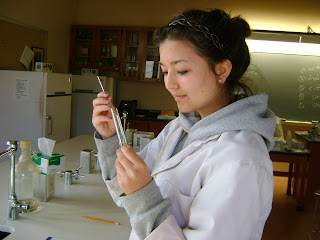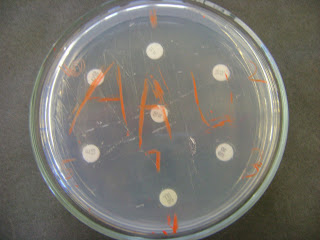As mentioned in last blog, during the last lab we stabbed the samples into the motility test tube and left it to incubate. After pulling the tube out and holding it up to the light under a magnifying glass, it is noticeable that there is a cloudiness spreading out of the line where we stabbed the bacteria with the inoculating needle. This is a positive test for a motile bacteria! This means that bacteria 'L' is motile! It grew at the entire length of the tube as well. Since there is anaerobic conditions at the bottom of the tube it is probable that our bacteria is able to survive in anareobic and aerobic conditions. However this is not proven, just an inclination; further tests will need to be elvaluated. Most likely since it grew consistantly through the tube we hypothesize that our bacteria is facultative. This means that the bacteria grows by utilizing oxygen but that it can also adapt to grow without the oxygen!
My throat sample (environmental) did not have a halo of cloudiness surrounding the needle stab. Therefore it is non-motile. It has been growing in the incubator therefore we know that it is aerobic. However we could not tell if it grew all the way down the motile test tube. Therefore we hypothesized that it is most likely obligate aerobic bacteria. This means it can only grow in the presence of oxygen.
After testing for motillity, we used our broth samples (from last lab) to make depression slides (so we could observe bacteria 'L' swimming under a microscope!). To begin, we flicked the broth tubes with our fingers. This swirling of the broth tubes caused a cloudiness to appear and reawaken the bacteria that had settled. We than took a slip cover to cover the depression slide and applied Vasoline to the corners of it. This helps it stick to the slide so the slide does not move (thereby making it easier to observe through a microscope). Using a sterilized, inoculating loop we applied the aseptic techinique to transfer a drop of the bacteria broth to the cover slip. Then flipping the depression slide upside down we stuck it to the cover slip (using the vasoline as the adhesive). The drop was now suspended over the bacteria!
Using a microscope on 400x (highest power) and using immersion oil, we could observe 'L' swimming! It was so awesome!
As we observed our bacteria, we also noted key aspects that will eventually help us determine the true name of 'L' after several more tests. So far from our class examination we have discovered that 'L' is a rod-shaped (bacillus) bacteria and also exhibits a red color.
Back to the previous lab, we did an experiment to determine if Dr. P had strep. As you can see in the picture, only partical lysing occured. The green residue is a dead giveaway for incomplete lysis. Penicillian did kill the bacteria (meaning he had throat bacteria on the agar medium plate) however since bacitracin did not kill the cells there was no
Streptococcus pyogenes on the plate (or therefore in Dr. P's throat!). Since complete lysis did not occur it is safe to say that Dr. P tested negitive for strep!Now it was time to take another look at the T4 bacteriaphage we placed in the incubator last lab. We used the same bacteriophage in two different agar plates (each containing a different bacteria). The agar plate with Dr. P's initials (JAP) the initials were clear all the way to the bottom of the plate, indicating that a complete lysis had occured. The other agar plate had no lysis occur! This proves that bacteriphages only affect specific hosts! This is why certain diseases are transmittible to humans through certain viruses! It is also why animal viruses & bacterias affecting humans was such a huge deal. If it can be transmitted to humans from animals, it is twice as contagious.
Incomplete lysis by antibiotics on blood agar plate
T4 Bacteriophage affecting bacteria
Until next lab!
Annie B

















































